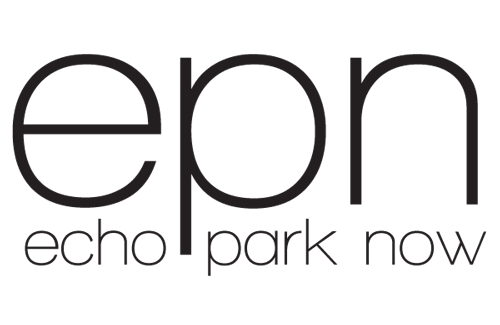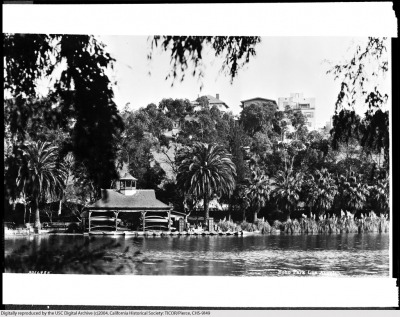Flashback Fridays – Early 20th Century Echo Park Lake
We recently found some photos in the University of Southern California’s Digital Library of Echo Park in the very beginning of the 20th century.
We’ve posted some of the pictures here for your enjoyment. The photo above was accompanied by a lovely account of the beginnings Echo Park Lake written by Jose Rivera.
Initially, the area we now know as the park was a natural arroyo that filled with water from a spring-fed stream that originated at Baxter Street and flowed down what is now Echo Park Avenue. In 1868 the Los Angeles Canal and Reservoir Co. dammed the arroyo to make a reservoir that aided in powering a woolen mill at what is now 6th and Figueroa (then known as Pearl St.) and was to eventually serve local residents, walnut orchards and vineyards to the south along Alvarado. The immigrants that worked these orchards and vineyards settled here and began to build small homes along Sunset Boulevard, between Echo Park Avenue and Lemoyne Street.
In 1875, the woolen mill closed and the reservoir land (then known as the Montana Tract) was sold off. Eventually, Thomas J. Kelley and Dr. W. Lemoyne Wills purchased the land for a business venture. In 1888, Mr. Kelley and Dr. Wills donated the land to the city for the expressed purpose of creating a public park for the enjoyment of the people of Los Angeles.
The first Superintendent of Parks for the city was an English immigrant named Joseph Tomlinson who was assigned the task of creating the park. One day, while overseeing the work, Mr. Tomlinson thought he heard his workers talking during a break, but he knew they were across the park from him. The park had an echo! He knew what the name of the park would be! The park was dedicated and opened to the public in 1895. The famous bed of lotuses that grow in the lake at the northwest end of the park, the largest stand of lotuses outside Asia, is a mystery yet to be solved. One legend says that evangelical Chinese missionaries planted them for use as food, but no one knows the real story. They appeared some time in 1923 or 1924.
Click below to view more photos.




http://beebedevine0.aircus.com/tips-memilih-permainan-judi-bola97
http://www.ubiqueict.com/index.php?option=com_k2&view=itemlist&task=user&id=1338131
http://tasadeinteres.org/index.php?option=com_k2&view=itemlist&task=user&id=348083
http://solapurads.com/user/profile/16323
Greetings! Very helpful advice within this article! It is the little changes which will make the most significant changes. Thanks for sharing!
https://www.gapyear.com/members/lamontlanier9/
http://ahfinternational.org/members/lanierbeebe4/activity/264276/
Howdy, There’s no doubt that your website might be having web browser compatibility problems. When I take a look at your web site in Safari, it looks fine however, when opening in IE, it’s got some overlapping issues. I merely wanted to give you a quick heads up! Aside from that, excellent website!
http://www.johnsonclassifieds.com/user/profile/810768
https://www.transtats.bts.gov/exit.asp?url=http://107.152.47.106/
http://www.massageads.co.uk/author/lanierdevine2/
Everything is very open with a precise clarification of the issues. It was really informative. Your site is useful. Many thanks for sharing!
http://www.ugodambrosi.it/index.php?option=com_k2&view=itemlist&task=user&id=1733408
Can I simply say what a comfort to uncover an individual who really understands what they’re talking about online. You definitely realize how to bring an issue to light and make it important. A lot more people ought to check this out and understand this side of the story. I can’t believe you aren’t more popular given that you surely possess the gift.
http://manejeaqui.com/uncomplicated-plans-in-russian-wives-for-2012/
http://livemorehappy.co/members/saundersbeebe5/activity/193089/
http://ask.gamifica.me/index.php?qa=user&qa_1=devinelamont6
http://supersoapbox.com/members/mcphersonemborg9/activity/124292/
http://www.loolalab.com/index.php?option=com_k2&view=itemlist&task=user&id=1177505
http://forum.4x4nation.com/members/kristiansenmcpherson9/activity/302071/
https://answers.informer.com/index.php?qa=user&qa_1=hildebrandtfields5465
Hi, I do believe this is a great blog. I stumbledupon it 😉 I am going to return once again since I saved as a favorite it. Money and freedom is the greatest way to change, may you be rich and continue to help others.